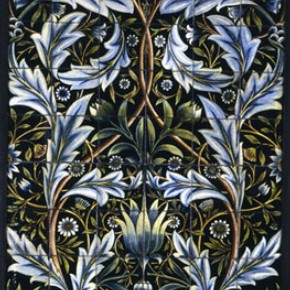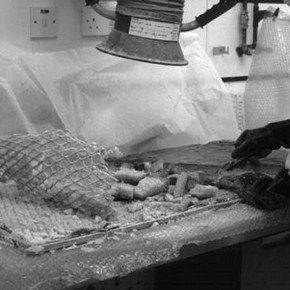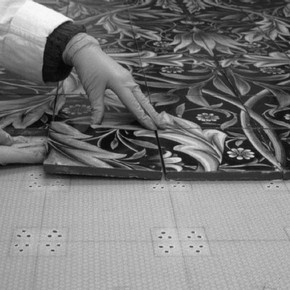Conservation Journal
October 1999 Issue 33
The Remounting of a Victorian Tile Panel
Introduction

Figure 1. Panel of tiles designed by William Morris, William De Morgan, 1876. Museum No. C36-1972, 1600 x 915mm (click image for larger version)
Tiles of diverse form, use and decorative theme will be on view in the British Galleries. They range from medieval floor tiles, through hand-painted and transfer-printed tin-glazed earthenware tiles from the seventeenth and eighteenth centuries, to the eclectic designs of the Victorian Age, a time when widespread use was made of tiles in private and public buildings. The display will include encaustic floor tiles designed by A.W.N. Pugin for the Palace of Westminster and the highly decorative glazed wall tiles of William Morris and William De Morgan.
Most of the panels will be displayed vertically. This article describes the method used for mounting one of the largest panels. Tiles are frequently mounted together as a group. Previous methods of mounting have included the attachment of tiles directly onto wooden boards or the use of bolts and wires in holes drilled through the backs of the tiles. Others have plaster or synthetic resins forming the backing material. These can present reversibility problems or become unsafe with the breakdown of unstable materials.
The Membland Hall Panel
The 'Membland Hall Panel' (Museum No. C.36-1972) comprises sixty-six slip-covered and hand-painted glazed tiles and measures 1600 x 915 mm. It was designed by William Morris and produced by William De Morgan in 1876 on earthenware blanks from the Architectural Pottery, Poole (Fig 1). It is one of only six surviving panels commissioned to decorate a room at Membland Hall, Devon, which was demolished in 1928. The William Morris Gallery, Walthamstow, has a note alongside the original design for the panels indicating that they were intended for a bathroom. It is the only floral pattern by Morris for a tile panel on this scale and is executed in dark greens, browns, purple and white on a dark ground1 .
The panel has been displayed in the V&A since the 1970's and was included in the 1996 exhibition at the V&A, William Morris, 1834-1896. It was subsequently proposed for loan to the William Morris Exhibition at three venues in Japan in 1997 and for display in the British Galleries in 2001.
Condition of the panel
The condition of the Membland Hall panel is representative of a number in the V&A Ceramics Collection where the tiles are in relatively good condition compared to the mounting systems which have deteriorated or failed. The tiles had been mounted in the 1970's as four separate panels held together in a wooden frame. They were backed with polyurethane foam reinforced with expanded aluminium mesh and containing wooden blocks for screw attachments. All these components formed a single heavy object.
By 1996 movement of the panels had caused areas of grouting to become dislodged, allowing the tiles to touch each other and increasing their vulnerability to impact damage. For the duration of the William Morris exhibition at the V&A it was decided to position Plastazote® strips between the frame's backboard and the tile backing material to minimise the movement of the four panels during handling. Before this exhibition went on to tour Japan, the panel underwent further condition assessments which concluded that it was not suitable to travel with its present mounting system.
Polyurethane foam is a rigid material formed by mixing two liquid components and the rate of foaming can be difficult to control. In places it had not foamed sufficiently and was hard and brittle. Also, in some areas the foam layer was so thin that the aluminium mesh almost rested on the backs of the tiles, making it difficult to remove.
There were also a number of old repairs and minor damages which required treatment. Large areas of the original tile surface had been over-painted in an attempt to disguise abraded or pitted areas. A small number of tiles have large areas of loss but most of the structural damage is minor in the form of chipped edges. All areas of loss had been filled and skilfully retouched in the past but the restored areas had become dull and discoloured.
Conservation treatment proposal
A treatment proposal and time estimate was agreed prior to the loan being approved. It was proposed to remove the tiles from the aged backing materials, to clean and upgrade the existing repairs before remounting them as one panel.
The criteria for a suitable tile backing material include the need for it to be a rigid and strong, though lightweight, means of support. It should be easy to apply, have good ageing properties, should not be hazardous to the health of the user and be reversible with no risk to the tiles. Aerolam 'F-Board'®2 (26.5 mm thick) was selected. It comprises a core of Aeroweb® aluminium honeycomb with a woven glass fibre reinforced plastic skin and two layers of glass cloth giving an average weight of 4.21kg/m. The benefits of the honeycomb sandwich structure include a very low weight and rigidity in several directions3 . The method described below for mounting a large number of tiles as one panel was designed to minimise the risk of damage during travelling and for hanging on open display.
Conservation treatment

Figure 2. Removing the polyurethane foam backing. Photograph by Fiona Jordan (click image for larger version)
Hand tools were used to cut through the brittle foam and remove the aluminium mesh (Fig 2). This was a slow process involving the removal of the top layer of foam to prize the mesh away from the tiles section by section. When a number of the tile backs became exposed, the surrounding grouting could be cut through and the tiles separated. The tile backs were cleaned, the disfiguring repairs to the glazed surface prepared for retouching and the tiles numbered in sequence.
The Aerolam 'F-Board'® was cut to size and the tile positions marked out. To allow the tiles to be easily reversible, a number of holes were drilled through the board where the adhesive would be positioned at the corners of each tile. The holes would allow solvent fumes to be used to reverse the procedure in the future by penetrating to the adhesive on the tile backs. The backs of the tiles were sealed at each corner with Paraloid B72™ in acetone (10-20% (w/v)). The board was lightly abraded prior to bonding. Araldite® 2015, a two part epoxy resin in paste form, was applied to each tile corner. A working time of forty minutes at 25°C allowed all sixty-six tiles to be correctly aligned and levelled before curing (fig 3). All Purpose Polyfilla™ tinted with dry artist's pigments was used to grout between the tiles.

Figure 3. Mounting the tiles on a prepared Aerolam® board. Photograph by Fiona Jordan (click image for larger version)
A wooden frame was constructed, Plastazote® foam placed in the rebates and dove-tailed battens attached to the back of the frame. The complete object weighs 69 kilograms, considerably less than in its previous form, allowing for easier handling and display.
Since the panel was remounted, it has successfully travelled to three exhibition venues in Japan and is currently in the 'Best of British' display at the V&A prior to be being hung on open display in the new British Galleries. Honeycomb sandwich panels, of various thicknesses, have proved to be a versatile backing material for ceramics and in other conservation disciplines.
Health and safety
Local extract ventilation and protective clothing were used when dismantling the tiles, cutting and drilling the Aerolam® board and using the epoxy resin.
Materials
Plastazote® (closed cell polyethylene foam) Zotefoams Ltd, 675 Mitcham Road, Croydon, Surrey CR9 3AL.
Aerolam® F-Board (Hexlite® 620), Hexcel Composites, Duxford, Cambridge, CB2 4QD.
Paraloid B72 (ethyl methacrylate methyl acrylate copolymer) Rohm and Haas (UK) Ltd, Lennig House, 2 Masons Avenue, Croydon, Surrey, CR9 3NB.
Araldite® 2015 (epoxy resin) Ciba Specialty Chemicals, Duxford, Cambridge, CB2 4QA.
All Purpose Polyfilla (calcium sulphate hemihydrate with cellulose ethers) Polycell Products Ltd, 30 Broadwater Road, Welwyn Garden City, Herts. AL7 3AZ.
References
1. Myers, R & H. (1996) William Morris Tiles, Richard Dennis, pp 123-124
Opie, Jennifer H. (1996) Tiles and Tableware, pp180-197. William Morris, edited by Linda Parry, Philip Wilson Publishers, London.
2. Aerolam® F-Board is now known as Hexlite® 620.
3. Ciba Composites. Aerolam Boards Publication No LGC 35C, March 1986.
October 1999 Issue 33
- Editorial - Changing Landscapes
- The British Galleries 1500-1900: An Overview
- 'Method in our Madness': Method Statements and the British Galleries
- Removal and Installation of Mirrors for the British Galleries Project
- The Remounting of a Victorian Tile Panel
- A Brief History of Mounts
- Don't Sit Down! The Investigation and Conservation of an Upholstered Seventeenth Century Settee
- Off-site Radio Telemetry
- Science Surgery
- Printer Friendly Version